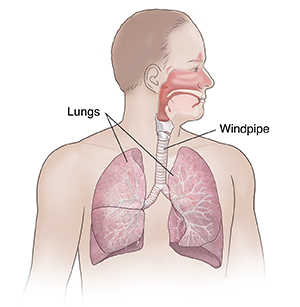Walking Pneumonia (Mycoplasma Pneumonia)
What is walking pneumonia?
Walking pneumonia is an infection of 1 or both of the lungs. It is caused by bacteria called mycoplasma pneumoniae. It attacks your respiratory system. This includes the lining of your throat, windpipe, and lungs. The bacteria spreads when a person coughs or sneezes small droplets of fluid into the air.
In adults, walking pneumonia can be mild. But pneumonia can be very serious. This is a higher risk for babies, young children, and older adults. It can be more serious in a person with other long-term health problems or a weak immune system.

What are the symptoms of walking pneumonia?
Symptoms may include:
How is walking pneumonia diagnosed?
Your healthcare provider will ask about your health history and current symptoms. They will also examine you. You may have tests such as:
-
A chest X-ray to look for fluid in your lungs
-
Blood tests to look for signs of infection
-
A sputum culture to see what is infecting your lungs
How is walking pneumonia treated?
Antibiotic medicine is used to treat this type of pneumonia. This is because it’s caused by bacteria.
Your healthcare provider may tell you to use other medicines, too. These are to help ease your systems. They may be prescription or over-the-counter. The medicines may include:
Check with your healthcare provider or pharmacist before taking any over-the-counter medicines.
You will also need:
What are possible complications of walking pneumonia?
Walking pneumonia is often mild. It may go away without treatment. In some cases, complications may occur. These can include:
What can I do to prevent walking pneumonia?
To prevent spreading or getting pneumonia again in the future:
-
Stay away from other people when you are sick, especially if you are coughing a lot.
-
Cover your mouth when you cough or sneeze. It's easy to pass this infection to other people through coughing. And also through contact with surfaces that you cough near.
-
Wipe off surfaces with antibacterial or disinfectant products. Wipe down phones, remote controls, and doorknobs.
-
Always put used tissues in a waste basket.
-
Tell people to wash their hands if they touch things you have coughed near.
-
Wash your hands often. Wash them before handling food or objects that others may touch. Use a separate towel or paper towels for drying. Scrub with water and soap for at least 20 seconds. Use hand sanitizer with at least 60% alcohol when you can’t wash your hands.
-
Ask your healthcare provider what vaccines you should get. This may include the flu and pneumonia vaccines. There is no vaccine to prevent walking pneumonia. But you can prevent other lung infections.
-
Don't smoke. Stay away from secondhand smoke. Tobacco damages the ability of your lungs to fight off infection.